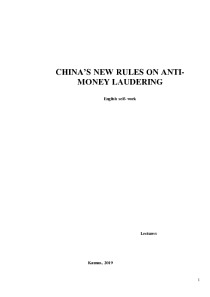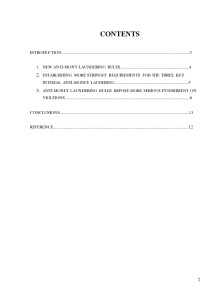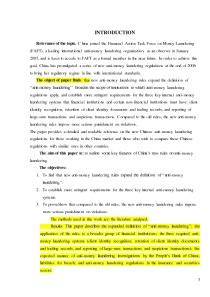China’s New Rules On Anti-money Laundering



Anti money laundering rules impose more serious punishment on violtions. Conclusions. Reference.
The aim of this paper is: to outline some key features of China’s new rules on anti-money laundering.
To find that new anti-money laundering rules expand the definition of ‘‘anti-money laundering’’.
To establish more stringent requirements for the three key internal anti-money laundering systems.
To prove/show that compared to the old rules, the new anti-money laundering rules impose more serious punishment on violations.
The methods used in this work are: the literature analyzed.
China joined the Financial Action Task Force on Money Laundering (FAFT), a leading international anti-money laundering organization, as an observer in January 2005, and is keen to accede to FAFT as a formal member in the near future. In order to achieve this goal, China has promulgated a series of new anti-money laundering regulations at the end of 2006 to bring her regulatory regime in line with international standards. Of most significance is the Anti-money Laundering Law of the People’s Republic of China (AML Law). The Standing Committee of the National People’s Congress passed the AML Law on October 31, 2006 as China’s first general law on anti-money laundering. Two weeks later, the People’s Bank of China (PBOC) issued two other regulations to implement the AML Law specifically in the case of financial institutions.
They are the Provisions on Anti-Money Laundering by Financial Institutions (FIAML Provisions) and the Administrative Measures on Reporting Large-sum Transactions and Suspicious Transactions by Financial Institutions (FI Reporting Measures). Both the AML Law and the FIAML Provisions became effective as from January 1, 2007, while the FI Reporting Measures became effective as from March 1, 2007. Before the promulgation of the AML Law, the anti-money laundering regime in China primarily comprised three regulations issued by PBOC effective since March 1, 2003.
They are the Provisions on Anti- Money Laundering by Financial Institutions, the Administrative Measures on Reporting Large-sum Transactions and Suspicious Payment and Transactions
An expanded definition of ‘‘anti-money laundering’’ The AML Law has expanded the definition of ‘‘money laundering acts’’ under the Old AML Rules by including such acts resulting from crimes of graft and bribery, crimes of undermining financial administrative order, and crimes of financial fraud. Accordingly, anti-money laundering is now defined as the act of taking measures to prevent money laundering activities that conceal the origin and nature of the proceeds and benefits derived from narcotics-related crimes, gang-type organized crimes, terrorism, smuggling, crimes of graft and bribery, crimes of undermining financial administrative order, and crimes of financial fraud.
- Economy & Finance Papers
- Microsoft Word 84 KB
- 2019 m.
- English
- 12 pages (2757 words)
- College
- Lina0229

















